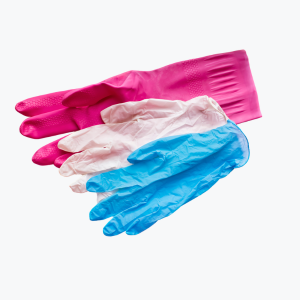In the realm of disposable gloves, glove thickness is a critical factor in ensuring safety and performance. The metrics commonly used for this purpose—grams (weight) and mils (thickness)—stand as benchmarks in the industry, each offering a unique perspective on the glove's material density and thickness. As we embark on this exploration of measuring disposable glove thickness, we delve into the significance of grams and mils, unraveling the complexities behind these measurements. From working on the manufacturing floor to the cleaning at home, the choice between grams and mils holds implications for durability, dexterity, and overall glove efficacy. Join us in this journey through the intricacies of disposable glove thickness, where the right measurement is more than a number—it's a crucial determinant of safety and quality in diverse professional environments.
Understanding Grams
In the context of disposable gloves, the measurement in grams refers to the weight of an individual glove. This specific measurement offers a direct insight into the density and heft of the glove, influencing factors such as tactile sensitivity and comfort. Manufacturers meticulously weigh individual gloves, ensuring consistency and meeting the desired specifications for various applications. When comparing disposable gloves based on grams, you're looking at the weight of a singular unit. The higher the grams the thicker the glove tends to be.
How to Measure Grams
Grams are calculated by assessing the mass of a single glove where each gram is equivalent to approximately 0.0352 ounces. When you see the weight on a glove listing it'll appear as a number with "g" at the end. The gram on the glove listing represents the average weight per glove for that model.
Understanding Mils
The most common measurement for glove thickness used in the industry is mils, a unit equivalent to one-thousandth of an inch. This meticulous measurement provides a precise gauge of the glove's thickness, offering insight into its durability and protective capabilities. For instance, a glove with a higher mil count is thicker, which usually means increased resistance to punctures and tears. Mils serve as a universal metric in comprehending the physical attributes of disposable gloves. This standardized measurement allows for clear comparisons, even between different glove materials, ensuring that professionals can select the appropriate thickness for their specific needs. Whether in healthcare, laboratories, or industrial settings, understanding mils is integral to making informed decisions regarding glove selection and ensuring optimal safety in the workplace.
How to Measure Mils
Mils are often mixed up with millimeters (mm), but the two measurements are drastically different. 1 mil is equal to one-thousandth of an inch. Because this measurement is so fine it's not something you can measure with a ruler, typically a micrometer or caliper are used.
Grams vs Mils
When choosing the right disposable gloves you'll often be provide both the grams and mils. This table provides a side by side comparison of the two measurement o[tions. Whether prioritizing cost-effectiveness, manufacturing precision, or specific application requirements, understanding these considerations is essential for professionals navigating the diverse landscape of disposable gloves.
| Aspect | Measuring by Grams (Weight) | Measuring by Mils (Thickness) |
|---|---|---|
| Unit of Measurement | Weight of an individual glove (grams) | Thickness in one-thousandths of an inch (mils) |
| Manufacturing Precision | Precise control over the weight of each glove. | Fine-grained measurement for thickness variations. |
| Sensitivity | Lighter weight may offer better tactile sensitivity. | Higher mil count can indicate increased durability and protection. |
| Variance | Weight may not be a universal indicator of thickness. | Some variability in measurements due to manufacturing processes. |
Choosing the right thickness
The importance of selecting the right thickness in disposable gloves cannot be overstated, as it directly impacts the level of protection, comfort, and overall performance in various professional settings. Choosing gloves with an appropriate thickness ensures resilience against potential hazards, such as punctures, tears, and chemical exposures, thereby safeguarding the wearer's hands. Additionally, the right thickness contributes to tactile sensitivity, allowing for precise and dexterous tasks without compromising safety. Whether in healthcare, laboratories, or industrial environments, the thoughtful consideration of glove thickness is a pivotal element in fostering a secure and productive work environment.

Thick Gloves
Thick disposable gloves play a crucial role in providing robust protection across a spectrum of demanding tasks. Their enhanced thickness makes them particularly well-suited for applications requiring resistance to punctures, abrasions, and exposure to chemicals. In industrial settings, tasks such as handling sharp objects, working with heavy machinery, or dealing with abrasive materials demand the fortitude that thick gloves offer. Similarly, healthcare professionals performing intricate medical procedures, such as suturing or handling medical instruments, benefit from the added durability and resilience provided by thick disposable gloves. The versatility of these gloves extends to laboratories, where researchers may encounter hazardous substances that necessitate a higher level of protection. In these scenarios, thick disposable gloves stand as indispensable allies, ensuring safety without compromising the tactile sensitivity required for precision tasks.
Thin Gloves
Thin disposable gloves find their niche in tasks that require heightened tactile sensitivity and precision. Ideal for delicate procedures in healthcare settings, such as administering injections, performing intricate surgeries, or conducting examinations, thin gloves offer the necessary dexterity without sacrificing protection. In laboratory environments, researchers handling sensitive equipment, intricate specimens, or conducting fine manipulations benefit from the agility and touch sensitivity provided by thin gloves. Moreover, in industries where fine motor skills are paramount, such as electronics assembly or intricate manufacturing processes, thin disposable gloves prove invaluable. Their lightweight and flexible nature make them the go-to choice for professionals who prioritize a balance between protection and precision in tasks that demand finesse.
Finishing Touches on Glove Thickness
As we reach the conclusion of our exploration of disposable glove thickness, we've uncovered a tapestry of considerations that go beyond mere measurements. With GloveNation you don't have to choose between grams and mils - we endeavor to use both measurements so you can make the best possible decision for your glove purchase. Whether your preference leans towards the tactile finesse offered by thinner gloves or the robust defense of thicker counterparts, the key lies in understanding the specific demands of your tasks. As we bid farewell to this journey, let's celebrate the diversity of gloves, each measured not just in grams and mils, but in the confidence, comfort, and safety they bring to hands in countless professional endeavors.
Check out our selection of Disposable Gloves
Shop these categories:


